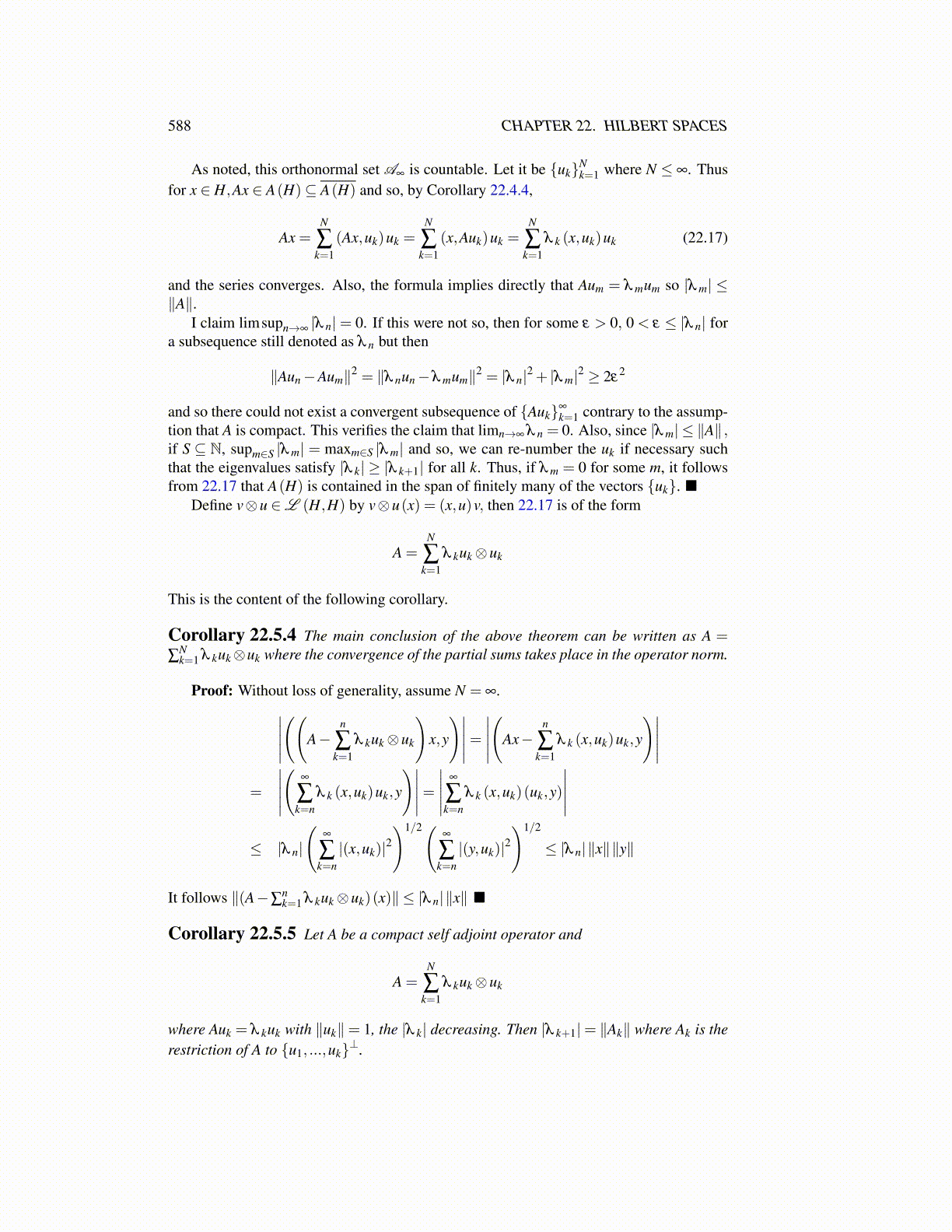
588 CHAPTER 22. HILBERT SPACES
As noted, this orthonormal set A∞ is countable. Let it be {uk}Nk=1 where N ≤ ∞. Thus
for x ∈ H,Ax ∈ A(H)⊆ A(H) and so, by Corollary 22.4.4,
Ax =N
∑k=1
(Ax,uk)uk =N
∑k=1
(x,Auk)uk =N
∑k=1
λ k (x,uk)uk (22.17)
and the series converges. Also, the formula implies directly that Aum = λ mum so |λ m| ≤∥A∥.
I claim limsupn→∞ |λ n|= 0. If this were not so, then for some ε > 0, 0 < ε ≤ |λ n| fora subsequence still denoted as λ n but then
∥Aun−Aum∥2 = ∥λ nun−λ mum∥2 = |λ n|2 + |λ m|2 ≥ 2ε2
and so there could not exist a convergent subsequence of {Auk}∞
k=1 contrary to the assump-tion that A is compact. This verifies the claim that limn→∞ λ n = 0. Also, since |λ m| ≤ ∥A∥ ,if S ⊆ N, supm∈S |λ m| = maxm∈S |λ m| and so, we can re-number the uk if necessary suchthat the eigenvalues satisfy |λ k| ≥ |λ k+1| for all k. Thus, if λ m = 0 for some m, it followsfrom 22.17 that A(H) is contained in the span of finitely many of the vectors {uk}. ■
Define v⊗u ∈L (H,H) by v⊗u(x) = (x,u)v, then 22.17 is of the form
A =N
∑k=1
λ kuk⊗uk
This is the content of the following corollary.
Corollary 22.5.4 The main conclusion of the above theorem can be written as A =
∑Nk=1 λ kuk⊗uk where the convergence of the partial sums takes place in the operator norm.
Proof: Without loss of generality, assume N = ∞.∣∣∣∣∣((
A−n
∑k=1
λ kuk⊗uk
)x,y
)∣∣∣∣∣=∣∣∣∣∣(
Ax−n
∑k=1
λ k (x,uk)uk,y
)∣∣∣∣∣=
∣∣∣∣∣(
∞
∑k=n
λ k (x,uk)uk,y
)∣∣∣∣∣=∣∣∣∣∣ ∞
∑k=n
λ k (x,uk)(uk,y)
∣∣∣∣∣≤ |λ n|
(∞
∑k=n|(x,uk)|2
)1/2(∞
∑k=n|(y,uk)|2
)1/2
≤ |λ n|∥x∥∥y∥
It follows ∥(A−∑nk=1 λ kuk⊗uk)(x)∥ ≤ |λ n|∥x∥ ■
Corollary 22.5.5 Let A be a compact self adjoint operator and
A =N
∑k=1
λ kuk⊗uk
where Auk = λ kuk with ∥uk∥= 1, the |λ k| decreasing. Then |λ k+1|= ∥Ak∥ where Ak is therestriction of A to {u1, ...,uk}⊥.